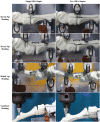Evaluation of Nitinol Staples for the Lapidus Arthrodesis in a Reproducible Biomechanical Model
- PMID: 26697432
- PMCID: PMC4677345
- DOI: 10.3389/fsurg.2015.00065
Evaluation of Nitinol Staples for the Lapidus Arthrodesis in a Reproducible Biomechanical Model
Abstract
While the Lapidus procedure is a widely accepted technique for treatment of hallux valgus, the optimal fixation method to maintain joint stability remains controversial. The purpose of this study is to evaluate the biomechanical properties of new shape memory alloy (SMA) staples arranged in different configurations in a repeatable first tarsometatarsal arthrodesis model. Ten sawbones models of the whole foot (n = 5 per group) were reconstructed using a single dorsal staple or two staples in a delta configuration. Each construct was mechanically tested non-destructively in dorsal four-point bending, medial four-point bending, dorsal three-point bending, and plantar cantilever bending with the staples activated at 37°C. The peak load (newton), stiffness (newton per millimeter), and plantar gapping (millimeter) were determined for each test. Pressure sensors were used to measure the contact force and area of the joint footprint in each group. There was a statistically significant increase in peak load in the two staple constructs compared to the single staple constructs for all testing modalities with P values range from 0.016 to 0.000. Stiffness also increased significantly in all tests except dorsal four-point bending. Pressure sensor readings showed a significantly higher contact force at time zero (P = 0.037) and contact area following loading in the two staple constructs (P = 0.045). Both groups completely recovered any plantar gapping following unloading and restored their initial contact footprint. The biomechanical integrity and repeatability of the models was demonstrated with no construct failures due to hardware or model breakdown. SMA staples provide fixation with the ability to dynamically apply and maintain compression across a simulated arthrodesis following a range of loading conditions.
Keywords: Lapidus model; biomechanical; nitinol staple; osteotomy; shape memory.
Figures






References
-
- Lapidus PW. The operative correction of the metatarsus varus primus in hallux valgus. Surg Gynecol Obstet (1934) 58:183–91. - PubMed
-
- Hansen S. Functional Reconstruction of the Foot and Ankle. Philadelphia, PA: Lippincott Williams Wilkins; (2000).
LinkOut - more resources
Full Text Sources
Other Literature Sources

